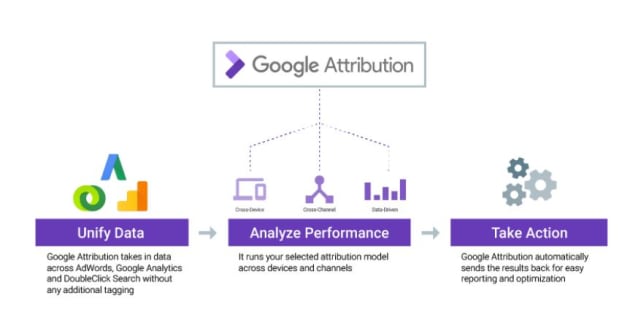
Google has launched attribution tools that attempt to move attribution modelling away from last click and measure the impact of some offline media.
Google Attribution combines data from AdWords, Google Analytics and DoubleClick Search and promises to use machine learning to determine how much credit marketers should assign to various digital touchpoints in a consumer journey.
The aim is to provide cross-channel attribution, long considered the 'holy grail' for marketers trying to analyse how effective campaigns are. At present, a lot of marketers default to last click attribution, which fails to consider the role of touch points further up the marketing funnel.
“Every day, Google analytics processes half a trillion digital moments across devices, which is just an astounding amount of data. We’re at the leading edge of making sense of that data,” Google VP of product management for AdWords Jerry Dischler said in a media briefing.
“As an AI first company we’re using this technology to help those advertisers make sense of this and make advertising platforms more useful, easier and better connected.
“Google Attribution will take the complexity out of measuring the value of every online marketing channel to gain a better understanding of your online marketing investment.”

Babak Pahlavan, the senior director of product management for Google Analytics 360 Suite and Measurement, explains that attribution tools have four flaws: they are difficult to set up, they are very complex, they lose track of the customers when they switch device, and they do not integrate well with other marketing tools.
“Attribution is about assigning values to each of these steps…it’s a pretty hard thing to do and a lot of marketers, because it is very difficult, they just give up and assign the entire credit ton the last thing the customers did. Maybe if they click on a display ad, such a search, they say ‘that thing was responsible for this purchase’,” Pahlavan said.
The product is based on a rebuild of Adometry, an analytics company Google acquired three years ago.
The way it works is that you connect your Google accounts, import your data and choose the attribution model you want and see the results that work best. Then you can export the model to your preferred Google account you like and optimise your campaigns to use the attribution model.
“Something that takes months and months to do you can literally do in a few minutes,” Pahlavan added. “Google Attribution is cross device, its cross channel, it’s integrated in its use, actionable and it's free.”
TV industry concerns
What's particularly intriguing about the new product is that Google will try to measure the impact of television advertising and this could even be rolled out to digital outdoor in the future.
Google says it will do this by measuring the digital impact TVCs have on brands by correlating the time TV ads air to spikes in related activity on search engine and brand websites, a technique that is currently being used by a small number of niche attribution firms, including Agile in Australia.
It may also expand this capability to measure the impact of digital outdoor but will not consider print.
This latter component has some industry sources concerned, with one senior television executive raising doubts about how effective this would be in reality.
The main concern centres around the notion that TV advertising is only being measured in how it drives direct call to actions, such as website visits and sales, when in reality the strength of TVCs is that they raise awareness and build brand value over a period of time.
This means discovery and awareness, which is much higher up in the marketing funnel, rather than clicks on websites (which most TV ads wouldn't even promote) or search engines.
There is a concern that Google could be trying to underplay the role of offline media by further controlling the tech that marketers use for cross channel attribution.
“It sounds very much like they’re looking to mark their own homework again but in a more palatable way to marketers,” a senior TV network executive, who wished to remain anonymous, told AdNews.
Measuring click to cash register
Google is rolling out store sales measurement technology at device and campaign levels. This will allow marketers to measures how online ads are driving sales by tracking the consumer journey from click to cash register.
“For many marketers this is the holy grail of closing the loop between a digital ad click and a store purchase ad we’re going to be able to do this to scale starting very soon,” Dischler added.
The aim is to simply the amount of ad tech that marketers need, allowing Google to manage the whole process.
In addition, Google has added location extensions to its YouTube video ad format that allow brands to help consumers identify the nearest store to their location, using smartphones and Google Maps technology.
Have something to say on this? Share your views in the comments section below. Or if you have a news story or tip-off, drop us a line at adnews@yaffa.com.au
Sign up to the AdNews newsletter, like us on Facebook or follow us on Twitter for breaking stories and campaigns throughout the day.


